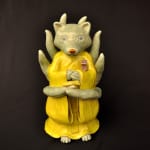Shayne Phua
A Confucius for everyday folk (celery), 2024
Ceramic
31.5 x 20 x 18 cm
Further images
-
(View a larger image of thumbnail 1
)

-
(View a larger image of thumbnail 2
)

-
(View a larger image of thumbnail 3
)

-
(View a larger image of thumbnail 4
)

-
(View a larger image of thumbnail 5
)

-
(View a larger image of thumbnail 6
)

-
(View a larger image of thumbnail 7
)

-
(View a larger image of thumbnail 8
)

This suite of four statuettes brings together the figures of the nine-tailed fox of East Asian mythology, and the Chinese sage and philosopher, Confucius. (See You turn Confucius on his...
This suite of four statuettes brings together the figures of the nine-tailed fox of East Asian mythology, and the Chinese sage and philosopher, Confucius. (See You turn Confucius on his head.) It is common Chinese practice to pray to Confucius for good grades – the historical figure having been deified – and, here, Phua is making a cheeky statement about the rituals of popular religion in the Sinosphere. These Confucian fox deities are depicted bearing everyday objects that, thanks to the homophonic nature of the various Chinese dialects, function as linguistic puns. The slab of beancurd, the artist points out, signifies a career in the civil service, considered a reliable occupation; the Hokkien term for dried tofu, kwa, sounds like the Mandarin term for an official, guan. Another fox figure holds out a sprig of leek, an allium vegetable the generic Mandarin word for which is suan – an exact homophone of the verb, suan, meaning ‘to count.’ It is thus associated with plenty, and financial and material well-being. The spring onion, or cong, suggests the desirable state of being intelligent, or cong ming; celery, also called qin cai, alludes to being hardworking, or qin lao.
Exhibitions
ART SG 2025, presented by Yeo Workshop, 17 – 19 January 2025, Marina Bay Sands Expo and Convention Centre, Singapore.A roast of Asian nine tails topped with broken femur and bile, accompanied by more curious ingredients, 20 July – 1 September 2024, Yeo Workshop, Singapore
1
of
12







